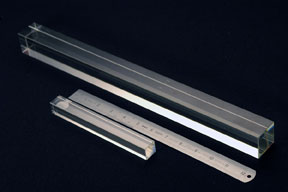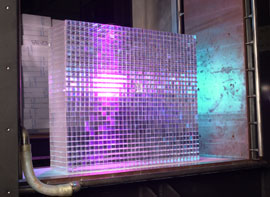The hybrid calorimeter, HYCAL, consists of two types of detector materials, shown here. The central section of HYCAL used 1152 lead-tungstate scintillator crystal assemblies (bare crystal, bottom), while the outer part was composed of 576 lead-glass Cerenkov counters (bare glass, top).
Newport News, Va. - A new measurement of the lifetime of the chargeless pion conducted at the Department of Energy's Thomas Jefferson National Accelerator Facility is a factor of two more precise than the current world value. The preliminary result yields a pion mean lifetime of (8.20 ± .24) x 10-17s and is another step forward in understanding symmetry breaking in nature, a phenomenon that led to the evolution of matter in the early universe.
Broken symmetries in the early universe account for the presence of stars, planets and people. Nature continues to break the rules of symmetry, and physicists study modern-day symmetry breaking in hopes of shedding light on how the universe works. For instance, the spontaneous breaking of "chiral symmetry" gives rise to pions, particles that carry the strong force between protons and neutrons, binding them into the nuclei of atoms and accounting for 98% of the mass of the visible universe.
Pions are some of matter's simplest particles. Built from the same building blocks as protons and neutrons, pions come in three types, designated by electric charge (positive, negative and chargeless). Jefferson Lab researchers produced chargeless pions (built from up and down quarks and their anti-quarks) and measured how long they lived.
"This is the most precise measurement to date of the chargeless pion lifetime," says Ashot Gasparian, co-spokesman for Jefferson Lab's Primakoff Experiment (PrimEx) and associate professor of physics at North Carolina A&T State University. "The lifetime measurement agrees with the averaged value from previous measurements, but it is two-and-a-half times more precise," he adds. This result resolves a large uncertainty in the existing experimental measurements and confirms our present understanding of broken chiral symmetries.
The Particle Data Group's (PDG's) Particle Physics Booklet quotes an average world value of (8.40 ± .6) x 10-17s. Gasparian will present the PrimEx value, (8.20 ± .24) x 10-17s, at the American Physical Society's April Meeting 2007 in Jacksonville on Saturday, April 14.
The PrimEx experiment was carried out in Jefferson Lab's Experimental Hall B, which provides a high quality, tagged photon beam. The pions were produced via the Primakoff Effect, where two interacting photons produce a pion, which lives for billionths of a billionth of a second (82 attoseconds) before decaying back into two photons. Both decay photons were measured in a novel hybrid calorimeter.
The PrimEx collaboration has not yet analyzed all of its data but anticipates obtaining a final pion mean lifetime value that's a factor of five better than the PDG's current value. "Our preliminary result shows that the current theory describing this phenomenon is basically correct. Our anticipated final result will test at a much finer scale our current theoretical understanding," Gasparian says. The PrimEx collaboration has more than 70 members from 21 national and international institutions. This experiment was supported by the DOE Office of Science Nuclear Physics program, together with NSF programs in Major Research Instrumentation, Physics Frontiers Centers and Nuclear Physics.
Experts:
Ashot Gasparian
North Carolina A&T State University
Liping Gan
University of North Carolina at Wilmington
Rory Miskimen
University of Massachusetts, Amherst
For interviews, contact:
Kandice Carter
kcarter@jlab.org
757-269-7263
For more information, visit:
On Target Newsletter: Say Hi! to HYCAL
Editor's Note: Article updated to resolve broken link to newsletter article, Oct. 6, 2023.



